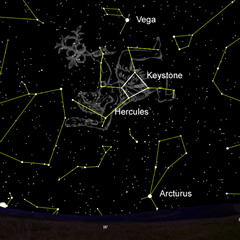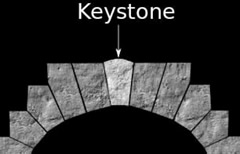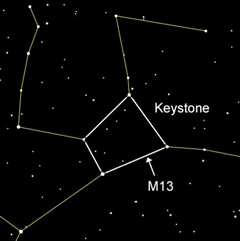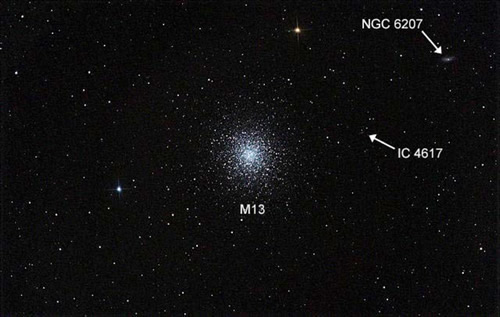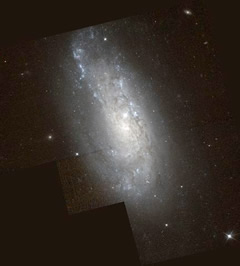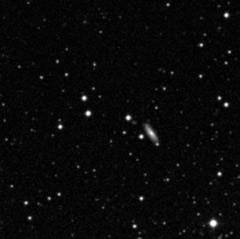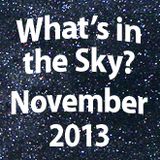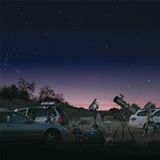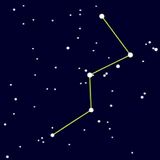
Each year as fall arrives, I wait with anticipation for my favorite objects to rise again, so that I can enjoy them for a new season. I always make sure to visit a few notable summer targets too, to savor them before they leave.
As Hercules is sliding further each day toward the western horizon, let's visit The Great Hercules Cluster, M13 - perhaps the grandest globular cluster in the northern sky. Now is the perfect time to observe its "Triple Treat" before it disappears into the evening twilight until next year.
M13 is an easy to find target, as it is situated from our vantage point along a constellation line in the asterism known as "The Keystone," in the constellation Hercules.
The Keystone in Hercules is the four-star asterism many amateur astronomers use to find Hercules; located between the bright summer stars Vega and Arcturus. Search just west of Vega to find the Keystone. Hercules stars are not among the brightest, so the sky must be reasonably dark to locate it.
The term "Keystone" comes from early stone doorway or arch construction. The keystone is the top piece whose symmetry locks the stones below on either side in place. Something of a parallelogram, but broader on one end, You'll come to recognize this shape in the stars of Hercules.
Along the western edge of The Keystone, you'll find M13, roughly one third the distance toward the small end of The Keystone.
On a dark night away from light pollution, if your vision is average, you can see stars down to about 6th magnitude. The stars of The Keystone are all brighter than magnitude 6, so in a dark sky you'll easily see them.
M13 shines at magnitude 5.78, so you can see it as a faint glow with just your eyes.
With a pair of binoculars, or small telescope, it becomes instantly apparent that M13 is not a faint star, but a round hazy glow. That's the view you'll get in telescopes up to roughly eight inches, although the larger the instrument, the brighter the glow.
In telescopes ten inches and above, the stars in this great cluster begin to resolve - you can start seeing individual stars. The cluster will show hundreds of stars in a very round ball, like a globe of stars. It is stunning to see in larger instruments - dazzling in fact.
Visually, the cluster is incredibly dense toward its core. It thins gradually, about one third from the core the density appears to drop off, then after another two thirds you'll find chains of stars, strings, weaving their way out toward the far reaches of the cluster. It is truly hard to believe this object is real!
But why do I call M13 a "Triple Treat?" Two other targets sit within about one wide-field eyepiece view away. Just under 1/2 degree north of M13 is the spiral galaxy NGC 6207. At magnitude 12.5 it is within reach of smaller telescopes. I use the two bright stars off either side of M13 to provide direction, and follow along that axis from M13 to see the dim but obvious glow of the galaxy.
If you have a large enough telescope - perhaps 12 inches or more, you can try to observe what is considered a challenge object in the same field of view. IC 4617 is a distant spiral galaxy that, in most telescopic views, appears only as a "fuzzy" fourth star in a dim four-star parallelogram. It is listed at magnitude 16, so you will need very dark and steady skies, and patience (watch for a while to see if it "pops out" of the darkness.) It is located just over twelve arc-seconds from M13 in the direction of NGC 6207.
Of course, seeing these objects is pleasing. M13 for its aesthetic beauty, NGC 6207 for is relative line-of-sight proximity to the big cluster, and IC 4617 for its challenge.
But the "mind-candy" part of the observer's equation is equally enticing. M13 is, of course, in our own Milky Way galaxy, it is our galactic companion in a universe of other galaxies. Its light, when it reaches our eyes, is 25,000 years old, having left the cluster during the Earth's last great Ice Age. The cluster contains an estimated 300,000 stars, spans 145 light years, and incredibly, is thought to be nearly 14 billion years old - as old as the Universe!
Looking out to NGC 6207, you are viewing through open space about 45 million light years. Roughly the distance of the great Virgo Galaxy Cluster - which we'll observe next Spring. If you are lucky enough to detect little IC 4617 though, you've won the prize - as it is a mind-bending 489 million light years distant. Light that has traveled nearly half a billion years, into your eye, to tickle the optic nerve in your head! So you can put into perspective just how "local" M13 really is.
Get out and enjoy these beautiful and interesting views, before they leave for the season!
Charts created with Starry Night Pro. Other images courtesy Wikipedia. NGC 6207 from Hubble Space Telescope.
Mark Wagner is a life-long astronomy enthusiast and deep sky observer. He has spent the past twenty years popularizing amateur astronomy in the San Francisco bay area through his writing and community building. A past president of the San Jose Astronomical Association, he founded what is now the annual Golden State Star Party in California. Please post if you have comments, questions, sketches or images you've taken of the targets mentioned above.




